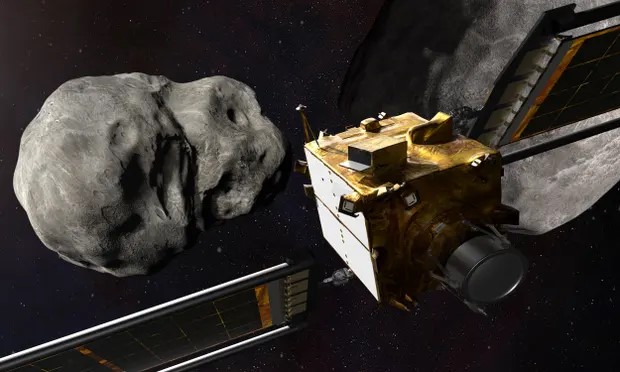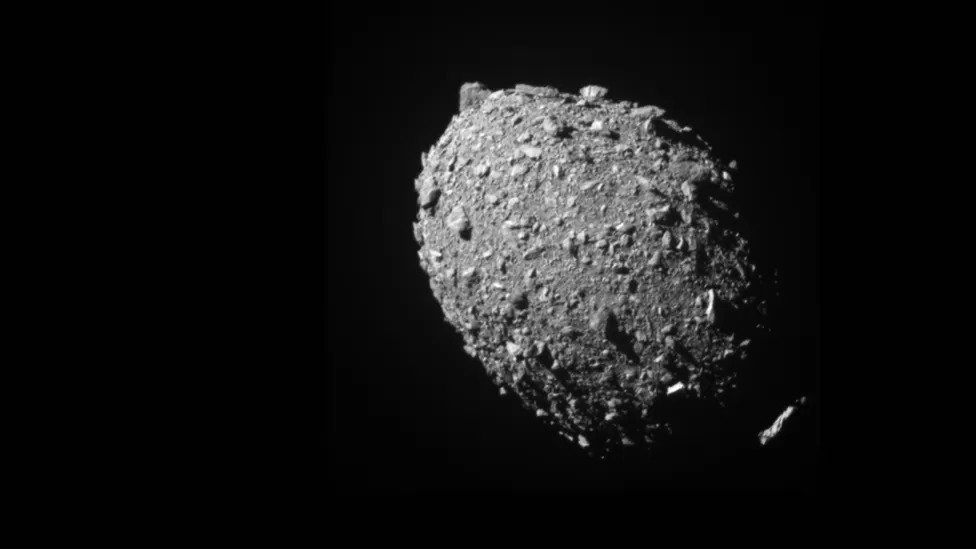
The American space agency announced on Tuesday that its DART probe’s recent attempt to deflect the path of an asteroid was successful. This marks humanity’s first successful attempt to deflect an asteroid.
NASA scientists have now confirmed that the orbit of a 160m-wide space rock known as Dimorphos, 11 million km from Earth, was altered when the spacecraft DART struck its head last month. DART is the size of a refrigerator. It weighs just 570 kilos, making it around 10 million times lighter than Dimorphos. The goal was to see if the impact would change the course of Dimorphos, which orbits around another called Didymos.
The Double Asteroid Redirection Test
Analysis of data obtained over the past two weeks by NASA’s Double Asteroid Redirection Test (DART) investigation team shows the spacecraft’s kinetic impact with its target asteroid, Dimorphos, successfully altered the asteroid’s orbit. This marks humanity’s first time purposely changing an asteroid’s motion and full-scale demonstration of asteroid deflection technology.
“This mission shows that Nasa is trying to be ready for whatever the Universe throws at us,” said agency administrator Bill Nelson.
“I believe that Nasa has proven that we are serious as a defender of the planet,” he told reporters.
The space agency released official data on Tuesday to support its assessment. These included new pictures from the Hubble Space Telescope. There were also others from a small Italian satellite, or cubesat, that stood off from the impact by about 50km (30 miles).
CONFIRMED: Analysis of data obtained over the past 2 weeks by the #DARTMission team shows impact with Dimorphos has successfully altered the asteroid’s orbit by 32 minutes – marking the 1st time humans have changed the orbit of a celestial object in space! https://t.co/MjmUAFwVSO pic.twitter.com/4Qiy1mC4gK
— NASA Asteroid Watch (@AsteroidWatch) October 11, 2022
“This is something we can really be proud of as an international endeavor,” added Giorgio Saccoccia, the president of the Italian Space Agency. It was they who made the LICIACube microsatellites that recorded the lead-up to and aftermath of the collision. “I think our planet can feel a bit more safe for the future.”
💫 Nuove immagini dell'impatto della #DARTmission sull'asteroide #Dimorphos, che variato la sua traiettoria attorno a #Didymos di oltre 30 minuti.
✨ New images of DART's impact on #Dimorphos asteroid, which caused a deviation of its trajectory around #Didymos by over 30 minutes. pic.twitter.com/MSJXOvlf6W— LICIACube (@LICIACube) October 11, 2022
NASA confirms existence of asteroids as destructive as a nuclear bomb

The DART mission is NASA’s Planetary Defense Coordination Office’s first attempt to divert the impact of an asteroid.
NASA had defined a minimum successful period change of Dimorphos of 73 seconds or more. The official results released on Tuesday show DART surpassed this benchmark by more than 25 times.
“This is a 4% change in the orbital period of Dimorphos around Didymos. DART just gave it a small nudge. But if you wanted to do this in the future, you’d want to do it years in advance,” commented Dr Nancy Chabot from the Johns Hopkins University Applied Physics Laboratory, which led the mission for NASA.
She adds: “Warning time is really key here in order to enable this sort of asteroid deflection to be used in the future as part of a much larger planetary defence strategy.
NASA scientists are concerned with asteroids measuring 140 meters or more, of which they have successfully identified only 40%. These have the same destructive power of a nuclear bomb. The threat is so significant that in 2017 NASA approved $324 million to make the DART mission a reality.
NASA’s planetary defence officer, Lindley Johnson, backed the initiative of developing asteroid deflection technology, stressing its immediate necessity.
“We don’t want to be in a situation where an asteroid is headed toward Earth and then have to be testing this kind of capability,” Lindley Johnson said.
Aftermath of collision with asteroid
The last images captured by DART before its collision with the asteroid revealed that Dimorphos has an irregular and rocky surface.
Two days after, the SOAR telescope in Chile revealed the collision had turned it into something resembling a comet with a 10,000-km tail.
Teddy Kareta, an astronomer involved in the observation said, “It is amazing how clearly we were able to capture the structure and extent of the aftermath in the days following the impact.”
René Duffard, a researcher from the Andalusian Astrophysics Institute who collaborated on the mission, compared it to a pool of rocks gravity bound together.
“The impact released a seismic wave across the asteroid, which has acted more as if it were fluid than solid rock, which is why the enormous tail was formed,” he explained.
Further observations show that the tail is made up of dust. Unlike actual comet tails, contains no traces of water. DART program scientist Tom Statler added on Tuesday that NASA would continue investigating the composition of the asteroid and effects of the impact.
Creating a planetary defense system
The success of the DART mission is the first step in creating a planetary defense system. The data collected by the spacecraft, LICIACuba micro-satellite, and earth telescopes will help refine the models simulating possible collisions.
IMPACT SUCCESS! Watch from #DARTMIssion’s DRACO Camera, as the vending machine-sized spacecraft successfully collides with asteroid Dimorphos, which is the size of a football stadium and poses no threat to Earth. pic.twitter.com/7bXipPkjWD
— NASA (@NASA) September 26, 2022
“DART has given us some fascinating data about both asteroid properties and the effectiveness of a kinetic impactor as a planetary defense technology,” said Nancy Chabot. Cabot is the DART coordination lead from the Johns Hopkins Applied Physics Laboratory (APL) in Laurel, Maryland.
“The DART team is continuing to work on this rich dataset to fully understand this first planetary defense test of asteroid deflection.”
In 2024, the European Space Agency plans to launch Hera. Hera is a €130 million space probe that will reach Didymos and the remainder of Dimorphos in 2026. It will then perform a post-impact survey. Analysis will focus on the precise measurement of Dimorphos’ mass. It will also create a detailed three-dimensional reconstruction of the crater left by DART.
According to NASA, neither Dimorphos nor Didymos poses any hazard to Earth before or after DART’s controlled collision with Dimorphos.
See all the latest news from Greece and the world at Greekreporter.com. Contact our newsroom to report an update or send your story, photos and videos. Follow GR on Google News and subscribe here to our daily email!



